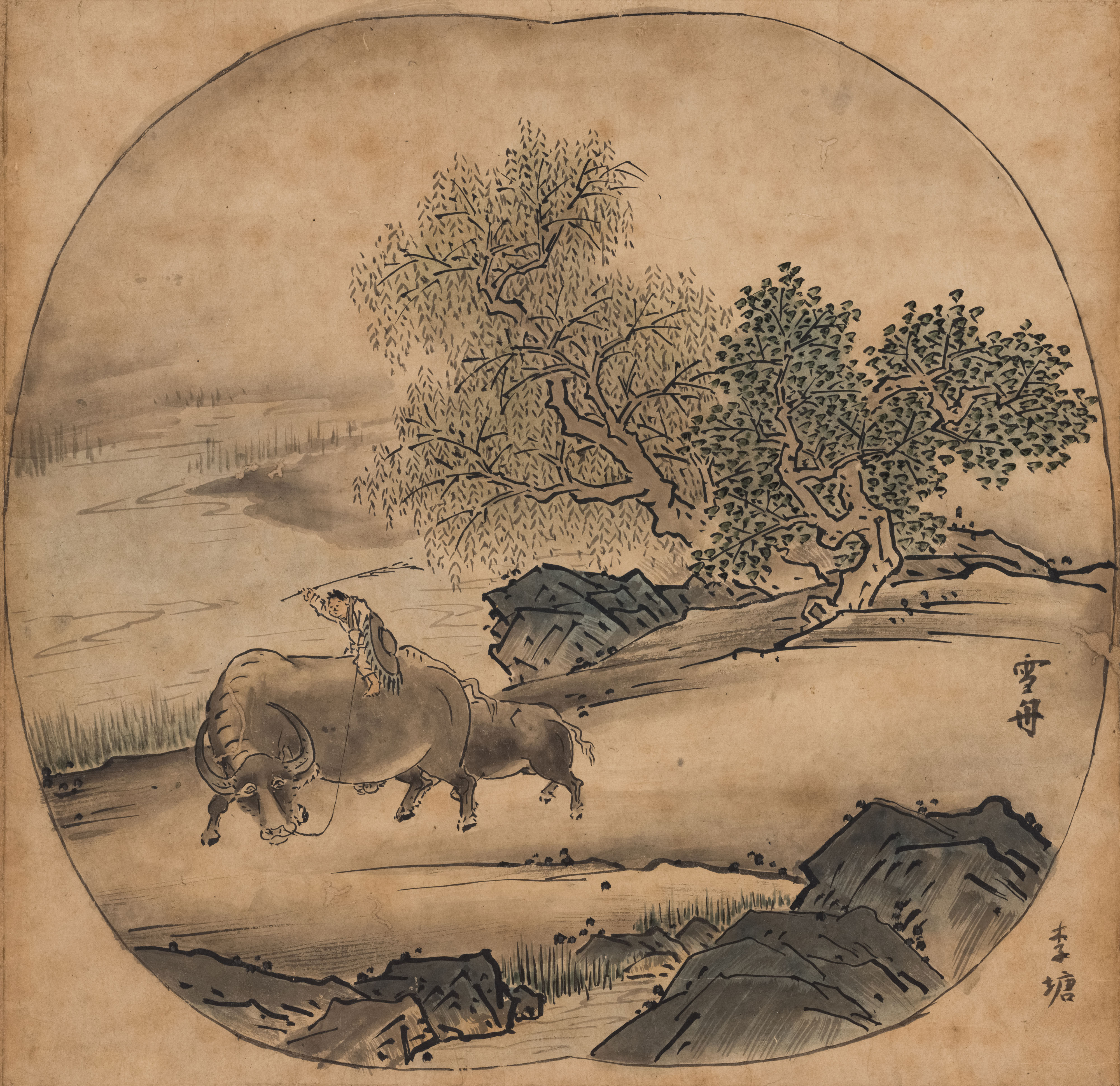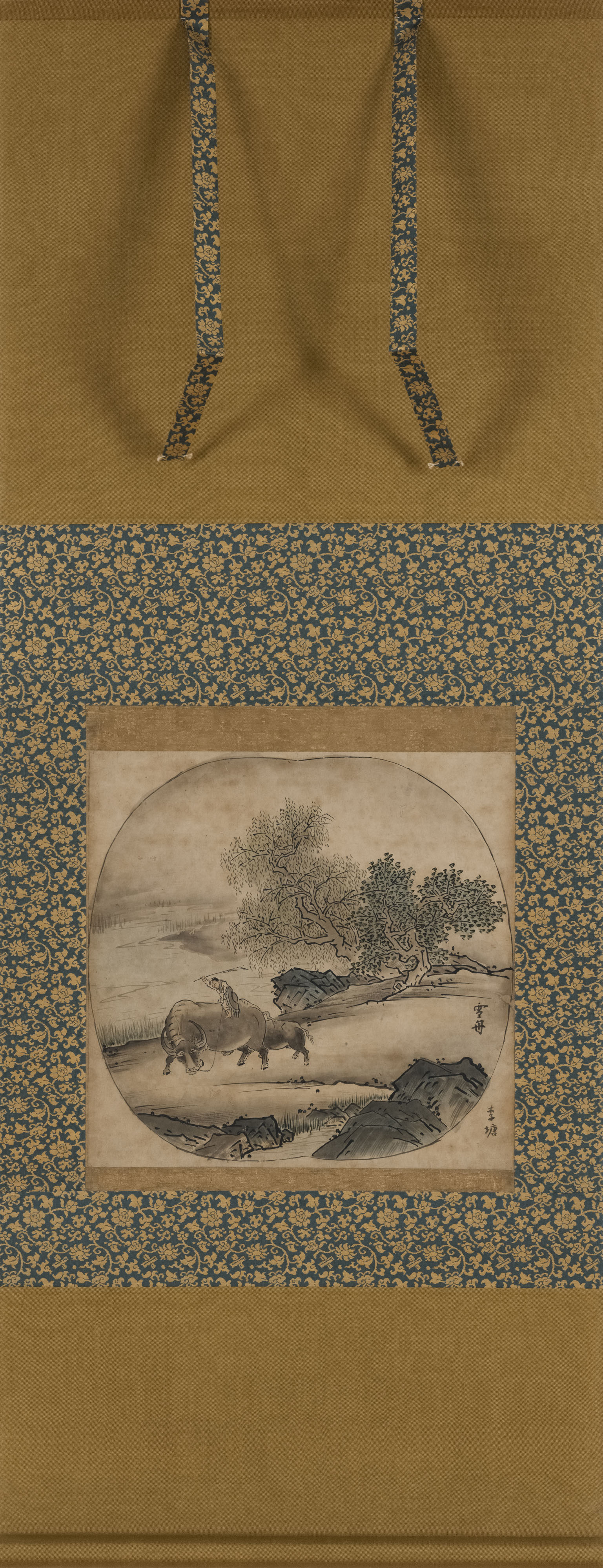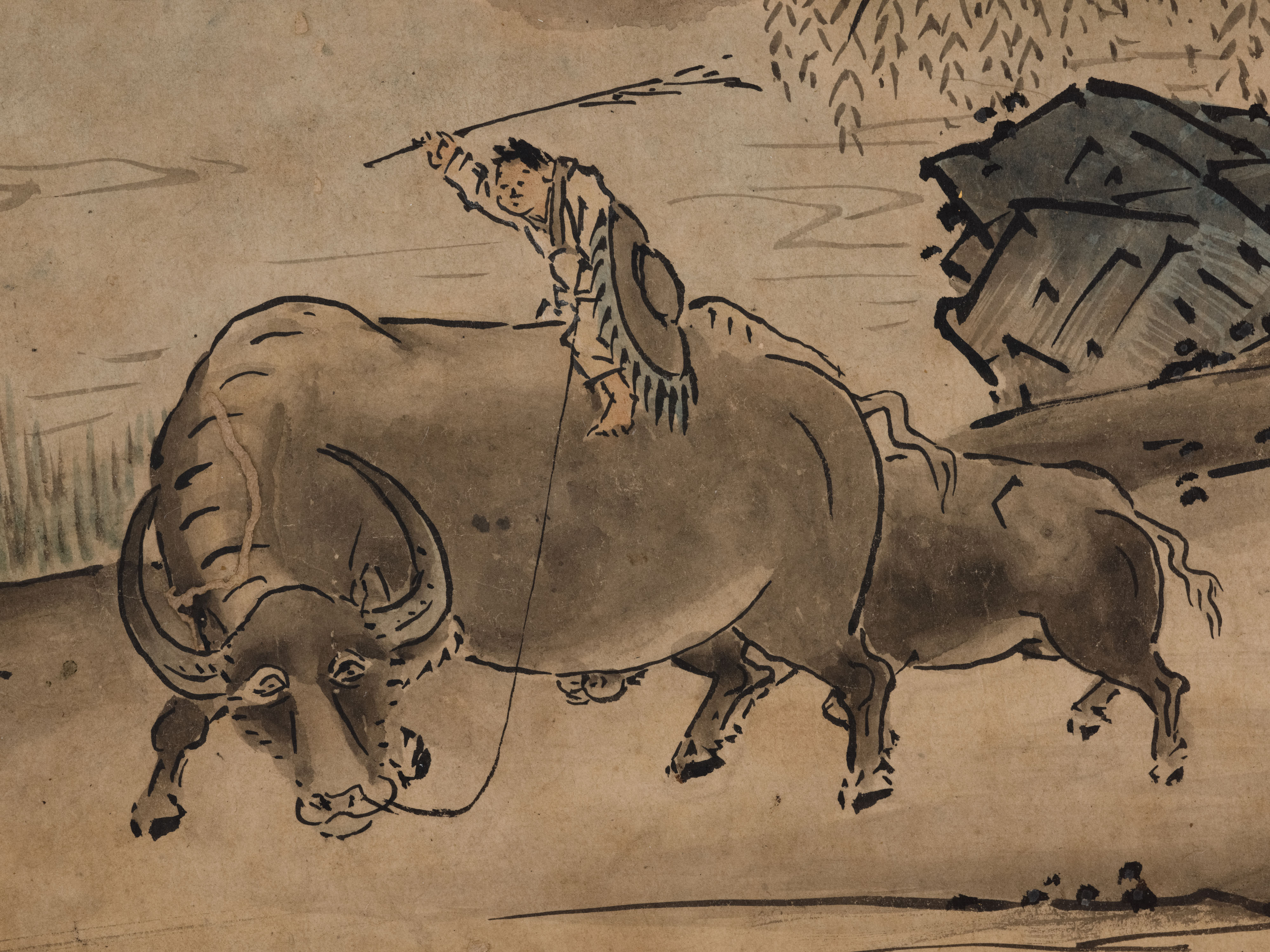
ぼくぎゅうず(ぼくどう) 牧牛図(牧童)
15th century(室町時代 15世紀)
紙本墨画淡彩
紙の上に団扇の形に線を引き、その中に絵が描かれています。画面右側の枠線の内側に「雪舟」という署名が記され、枠線の外側、画面右下隅に「李唐」という中国人画家の名前が記されています。この絵と同じように、中国の名画をお手本として団扇形に描いた雪舟の作品がいくつか残されており、シリーズとして制作されたものであることが判明しています。李唐は、中国・宋時代13世紀初めの画家で、山水や牛の絵を得意としました。この絵には、農耕に使う水牛に乗り、鞭がわりの枝をふるう子供が水辺の道を進む姿が描かれています。大きな親牛の後ろを子牛がついて歩いているのですが、子牛の頭は親牛の体に隠されてほとんど見えません。親牛の背中の上に乗る子供の顔には眉毛、目、鼻、耳がとても細かく描かれています。木の葉の緑色や、岩に塗られた青色など、色彩の美しい絵です。
雪舟等楊【せっしゅう とうよう】
生没年 1420~ca.1502(応永27年〜文亀2年頃)
日本美術史を代表する水墨画家。備中国(現在の岡山県)に生まれ、京都での禅僧としての修行を経て1454年(享徳3年)頃から大内氏の庇護を受けて山口に移住。1467年(応仁元年)、遣明使に参加して中国に渡り、本場の水墨画を学びました。個人としては最多の6点が国宝に指定されています。
| 寸法 | 30.3×31.4cm |
|---|---|
| 形状 | 掛幅 |

Herdsmen and water buffaloes
15th century
Ink and light color on paper
This picture is painted within a fan-shaped circle drawn on the paper. The picture has the artist’s autograph, “Sesshu”, inside the encircling line and the name of the Chinese painter, “Li Tang”, outside the circle, in the lower right-hand corner of the picture. Sesshu often painted pictures, as in the case of this work, in the form of a fan-shaped circle, modeled upon masterpieces of Chinese painting. Some of Sesshu’s works of this type still exist. It has been confirmed that they were produced as series. Li Tang was a Chinese painter who lived in the early 13th century, during the Chinese Sung Dynasty. He excelled at creating pictures of landscapes and cattle. This work depicts a child who is riding a buffalo used for farming. They are moving along a path at the waterside, while he wields a twig serving as a whip. When we examine the picture closely, we can see a calf following its big parent. However, we can barely see the calf’s head because it is hidden behind the adult buffalo’s body. The face of the child riding on the back of the big buffalo is finely depicted to reveal small details, including the boy’s eyebrows, eyes, nose and ears. This picture is beautifully painted in multiple colors, such as the green of the tree leaves and the tones of blue giving dimensionality to the rocks.
Sesshu Toyo (1420 – 1502)
In Japanese art history, Sesshu Toyo is a landmark ink painter. He was born in Bicchu Province (the present-day Okayama Prefecture). After training as a Zen monk in Kyoto, around 1454 he moved to Yamaguchi under the patronage of the Ouchy family. In 1467 he went to Ming Dynasty China, accompanying a Japanese mission, and learned the art of ink painting there, in the very home of ink painting. A total of six of his works have been designated as National Treasures. This is the maximum number of works so designated for any individual artist.
| Size | 30.3×31.4cm |
|---|

牧牛圖(牧童)
紙上有團扇形狀的線框,畫就在其中。畫麵右側的線框內署名“雪舟”,線框外側的右下角,寫有中國畫家“李唐”的名字。在雪舟留存至今的作品中,還有幾幅與此畫一樣,模仿中國名畫繪製的團扇形作品,能推斷出這些屬於同一個係列。李唐是中國宋代(13世紀初)的畫家,擅長畫山水和牛。此畫描繪了孩童騎著農耕水牛,揮著樹枝代替鞭子在水邊小道上前行。母牛後麵跟著小牛,由於母牛身體的遮擋,小牛的頭幾乎看不到。騎在母牛背上的孩童,眉,眼,鼻,耳都描畫得非常細致。樹葉呈綠色、岩石呈藍色,是一幅色彩優美的畫。
雪舟 等楊
生卒年 1420~ca.1502(應永27年~文龜2年前後)
日本美術史上的代表性水墨畫家。出生於備中國(現在的岡山縣),在京都作為禪僧修行,享德3年(1454年)起,受大內氏保護移居山口。應仁元年(1467年),參加遣明使前往中國,學習了正宗的水墨畫。是個人作品中榮譽最多的,有6件被指定為國寶。
| 尺寸 | 30.3×31.4cm |
|---|

목우도(목동)
화지 위 둥근 부채 모양으로 테두리가 그려져 있고, 그 안에 그림이 그려져 있습니다. 테두리 안 오른편에는 「雪舟(설주 *일본 음독: 셋슈)」라는 두 글자가 쓰여 있는데, 이것은 이 작품의 작가인 셋슈의 서명입니다. 그리고, 화면 우측 하단 테두리 바깥쪽 구석에 「李唐(이당)」이라는 중국인 화가의 이름이 적혀 있습니다. 이 그림처럼 중국의 명화를 참고로 그린, 둥근 부채 모양 테두리를 갖는 셋슈의 작품이 몇 점 남아있는데, 이 작품들은 하나의 시리즈로 제작되었다고 합니다. 이당은 중국 송 시대 13세기 초기의 화가로 산수화나 소 그림을 주로 그렸습니다. 이 그림에는 한 명의 아이가 채찍 대신 나뭇가지를 휘두르며, 물 근처에 난 길을 농사에 사용하는 물소를 타고 가는 모습이 그려져 있습니다. 큰 어미 소의 뒤를 송아지가 따라가고 있는데, 송아지의 머리는 어미 소의 몸에 가려 거의 보이지 않습니다. 어미 소 등 위에 탄 아이의 얼굴에는 눈썹, 눈, 코, 귀가 굉장히 자세하게 그려져 있습니다. 나뭇잎의 초록색이나 바위에 칠해진 푸른색 등 색채가 아름다운 그림입니다.
셋슈 도요
생몰년 1420년 ~ 1502년경 (오에이27년~분키2년경)
일본 미술사를 대표하는 수묵화가입니다. 빗추국(현재의 오카야마현)에서 태어나, 교토에서 선종 승려로서 수행을 거친 후, 1454년(교토쿠3년) 경부터 오우치씨의 비호를 받아 야마구치로 이주하였습니다. 1467년(오닌원년), 견명사가 되어 수묵화의 본고장인 중국으로 건너가 수묵화를 공부했고, 개인으로서는 가장 많은, 총 여섯 점의 작품이 국보로 지정되어 있습니다.
| 치수 | 30.3×31.4cm |
|---|


